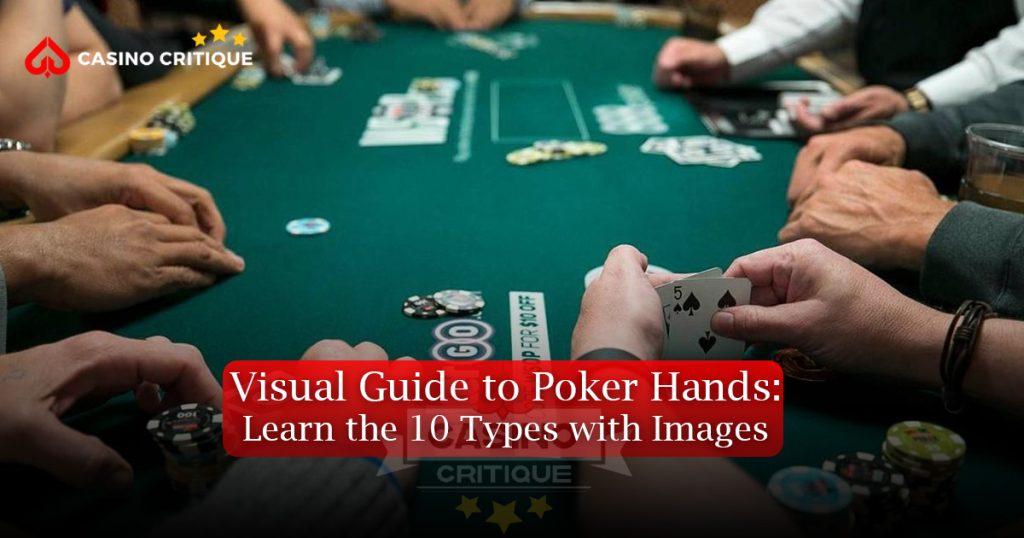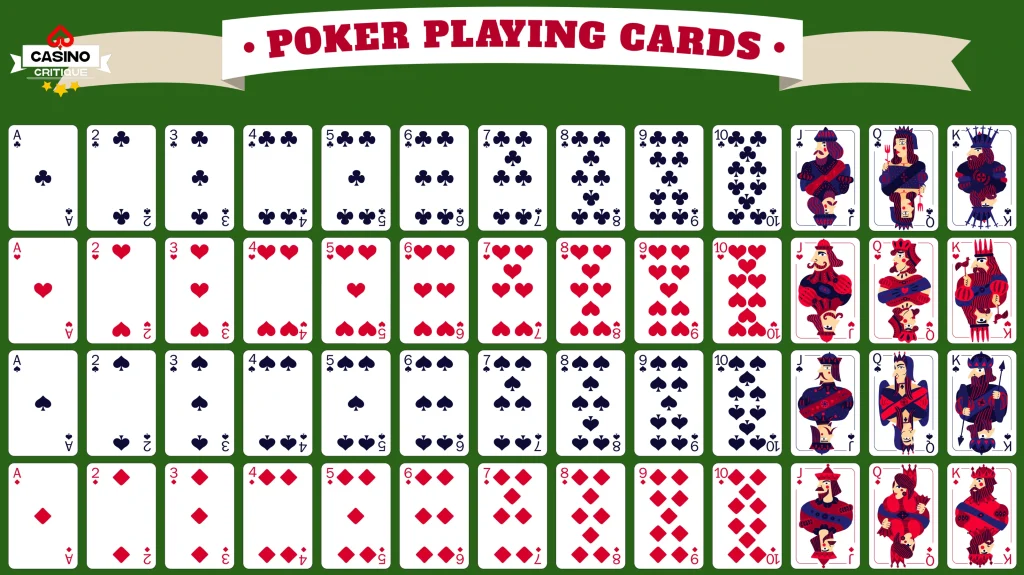
Introduction
Understanding the hierarchy of poker hands is essential for anyone looking to play poker well, whether at home, online, or in a casino. This guide outlines the 10 poker hands you need to know to play effectively, from the unbeatable Royal Flush down to the High Card, which is often just a backup when no other hand emerges.
With detailed descriptions, probabilities, and examples for each hand, this guide provides insights on when to play each hand and when it’s best to fold. Learning poker hand rankings allows players to gauge the strength of their hand in relation to others at the table and make better decisions regarding their bets.
For beginners, these rankings serve as a roadmap to poker basics, while advanced players can refine their strategies by revisiting fundamentals and hand probabilities. Mastering hand ranks is only part of poker success, though. Recognizing the strength of each hand in various situations and the potential hands your opponents may have are also key.
The goal is to make calculated bets based on hand strength, position, and potential competition at the table. For each hand type, we’ll cover its definition, examples, probabilities, and some strategic tips to ensure you know how to use each one effectively. Let’s dive into this detailed breakdown of poker hands and explore how understanding them can help you master the game, gain confidence, and make better betting choices as you progress.
Poker Hands Ranked: From Highest to Lowest

Royal Flush — The Crown Jewel
What It Is: A♦ K♦ Q♦ J♦ 10♦
Odds: 1 in 649,740
Pro Tip: Don’t chase it. If you hit it, slow play until the river and let opponents build the pot for you.
Trending Insight: In online games with AI analysis tools, Royal Flushes are more visible in player highlight reels, sparking a surge in bluff-based strategies mimicking this hand.
The Royal Flush is the most valuable hand in poker and consists of five high-ranking cards in sequence within the same suit: Ace, King, Queen, Jack, and 10. It’s the ultimate hand in poker and can’t be beaten by any other. Its rarity makes it particularly special, with the odds of obtaining it in a game like Texas Hold’em sitting around 1 in 649,740 hands【22†source】【24†source】.
When you have a Royal Flush, the hand is unbeatable, so if you’re fortunate enough to hold it, you can confidently bet or raise. However, keep in mind that because the Royal Flush is so rare, it’s often not worth chasing, and instead, players should build their strategy around more common hands. Having a Royal Flush also allows players to maximize their winnings in cases where other players are convinced they hold a good hand.
The key to effectively playing a Royal Flush, when it happens, is understanding that your opponents will often not expect it, especially if you play with restraint in the lead-up to your win. If you get a Royal Flush on the flop in Texas Hold’em, it may be wise to let others initiate the betting before coming in strong, allowing you to gradually build the pot. Visually, the Royal Flush is simple to identify—all top cards of the same suit in consecutive order.
Straight Flush — The Silent Killer
What It Is: Any five suited consecutive cards (e.g., 9♠ 8♠ 7♠ 6♠ 5♠)
Odds: 1 in 72,193
Strategic Tip: Position is power—if you’re late in the betting order, you can extract more value from uncertain opponents.
Trend: VR poker now displays advanced graphics showing hand strength heatmaps—great for spotting these hidden power plays.
A Straight Flush is the second-strongest hand in poker, ranking just below a Royal Flush. It consists of five consecutive cards in the same suit but without the requirement of the highest cards, like a 9♣ 8♣ 7♣ 6♣ 5♣. Odds for achieving a Straight Flush are about 1 in 72,193 hands, which is still quite rare, though not as uncommon as the Royal Flush【21†source】.
When you have a Straight Flush, you have a very high chance of winning the pot, and you should consider placing a significant bet to maximize your return. Straight Flushes can sometimes be overlooked by players focusing on pairs or other combinations, which can work to your advantage if you play conservatively at first. However, if you suspect an opponent could hold a Royal Flush, you may need to play cautiously.
If your Straight Flush has a King high, for instance, remember that an Ace-high Straight Flush, or Royal Flush, would beat you. Recognizing a Straight Flush is easier than some other hands, as the cards are all in sequential order within the same suit, providing a straightforward visual pattern.
Four of a Kind — “Quads”
What It Is: Four cards of same rank + a kicker
Odds: 1 in 4,164
Best Play: Bet boldly—this hand dominates most games. Watch for shared board cards; others might have it too.
Player Insight: GGPoker’s AI analyzers show many beginners under-bet this hand out of fear. Don’t!
Four of a Kind, or “Quads,” ranks third and consists of four cards of the same rank and one additional card known as the “kicker.” For example, holding four 8s, with a 5 as a kicker (8♠ 8♦ 8♣ 8♥ 5♠), would make a Four of a Kind hand【25†source】.
The odds of getting Four of a Kind are approximately 1 in 4,164, which makes it a high-ranking hand with substantial strength. This hand is a strong contender in most situations, as it’s only beaten by a Straight Flush or Royal Flush.
Therefore, when you’re fortunate enough to have Four of a Kind, you should play aggressively, especially if you’re confident no other players hold one of the two hands that can beat it.
When there are community cards, be mindful of the possible hands other players might hold; for instance, in Texas Hold’em, if the board shows three matching cards, other players may also have Four of a Kind. When betting, Four of a Kind usually allows for a significant raise, but don’t overlook the kicker, as in cases where two players hold Four of a Kind, the kicker determines the winner.
Full House — House Always Wins?
What It Is: Three of a kind + a pair (e.g., Q♣ Q♦ Q♥ 7♣ 7♦)
Odds: 1 in 693
Strategic Move: Bet steadily. Over-betting scares off lower-ranked hands like Flushes.
Modern Note: Online software now recommends Full House “slow-rolls” in soft games to increase payout odds.
A Full House combines three cards of one rank and two cards of another, such as Q♥ Q♣ Q♠ 7♠ 7♣, making it a solid hand in most poker games【23†source】. The probability of getting a Full House is around 1 in 693, so it’s more common than the top three hands but still uncommon enough to be valuable.
Full Houses are strong hands that are typically only beaten by Four of a Kind, Straight Flush, or Royal Flush. When playing a Full House, you have a strong chance of winning, so betting moderately to aggressively is often appropriate, depending on the situation.
Full Houses are highly recognizable due to the combination of three matching cards with a pair, and in games like Texas Hold’em, they can be particularly advantageous as other players might believe their flushes or straights are winning hands. The strength of a Full House depends on the rank of the three cards (for example, “Queens full of Sevens” beats “Jacks full of Tens”), so consider the board and what your opponents might be holding before determining your bet size.
Flush — Stylish & Deadly
What It Is: Five suited cards, not in sequence
Odds: 1 in 508
When to Bet: If you hold the highest card in your suit, raise confidently.
Warning: Avoid chasing draws in aggressive tables—AI simulations show it’s -EV over time.
A Flush consists of any five cards of the same suit, not in sequence, such as K♣ 10♣ 8♣ 6♣ 3♣. Flushes have a probability of about 1 in 508, making them relatively achievable but still valuable【24†source】. In many poker variants, a Flush is a strong hand, particularly because it beats a straight or lower combinations like pairs.
When holding a Flush, bet confidently but cautiously, especially if the board shows possible Full House or Four of a Kind hands. If there are other flushes at the table, the highest card in each flush determines the winner. For example, if both you and another player have flushes but yours includes a King and theirs a Queen, you would win the pot. Flushes are visually distinct due to the uniformity of the suits, making them easier to recognize at a glance.
Straight — The Equalizer
What It Is: Five cards in a row, different suits
Odds: 1 in 254
Play Tip: Great for mid-strength pots. Be wary of paired boards; your Straight could fall to a Full House.
Trend Alert: AI tools now flag Straight-dominated boards for cautious play—fold equity is low.
A Straight consists of five consecutive cards of varying suits, such as 7♠ 6♣ 5♦ 4♥ 3♠. The probability of obtaining a Straight is approximately 1 in 254, so it’s moderately common【22†source】. While strong, a Straight can be beaten by a Flush, Full House, or higher-ranked hands, so play accordingly.
With a Straight, moderate betting can be effective, but watch for the possibility of opponents holding stronger hands, especially if suited or paired cards are visible on the board. In poker games where straights are frequent, it’s wise to avoid overcommitting unless you’re confident of your hand’s relative strength.
Three of a Kind — “Trips”
What It Is: Three same-ranked cards + 2 kickers
Odds: 1 in 46
Smart Play: Don’t overplay this. If high cards are on the board, someone could have a better hand.
Digital Poker Insight: Tools like PioSOLVER show that many “Trips” hands are overvalued by 22% at novice level.
Three of a Kind comprises three cards of the same rank, with two unmatched cards (kickers). For example, having three fives and two other cards, like 5♠ 5♦ 5♣ 9♠ 4♠, would constitute Three of a Kind【25†source】. This hand appears about once in 47 hands and can often win small to moderate pots if other players don’t hold higher-ranked hands. When playing Three of a Kind, consider your position at the table and whether stronger hands might be in play based on visible cards.
Two Pair — Double Trouble
What It Is: Two pairs + one kicker
Odds: 1 in 21
Pro Strategy: A mid-game hand; use it to control pots, not dominate. Raise only if board is dry.
Trend: Solvers suggest Two Pair is best folded when an overcard hits the turn in multi-way pots.
Two Pair consists of two different pairs and a fifth kicker card, like 10♠ 10♦ 4♣ 4♦ K♠, appearing approximately 1 in every 21 hands【25†source】. Although Two Pair can be a good hand to bet moderately with, it’s vulnerable to Three of a Kind or higher combinations. The higher of the two pairs determines the strength of the hand, so a “Queens and Tens” Two Pair beats “Jacks and Nines.” With Two Pair, try a cautious betting approach.
One Pair — The Grinder’s Hand
What It Is: One pair + three other cards
Odds: 1 in 2.4
Key Tip: Be cautious. Only high pairs are worth value betting.
Stats: 60% of novice losses are from overplaying small pairs, especially post-flop.
One Pair contains two matching cards and three kickers, like Q♠ Q♦ 7♣ 4♠ 3♠. It’s the most common winning hand, with a 1 in 2 chance of appearing, typically shows up in about 42% of all hands, making it relatively common【24†source】【25†source】.
Though modest, One Pair can still win against High Card hands and sometimes other pairs, depending on the kicker. This hand allows for minimal betting unless you have a high-ranking pair (like Aces or Kings), in which case you may want to consider a stronger bet to intimidate weaker hands.
The value of One Pair is largely contingent on the pair’s rank and the kickers involved, so if you have a high pair and your opponents seem cautious, you might still turn a moderate profit. However, One Pair is best viewed as a safe fallback in situations where the competition’s cards don’t reveal any higher potential hands. Recognizing One Pair is simple: focus on locating the matching cards, then evaluate kickers for possible tiebreaks if necessary.
High Card — Last Resort
What It Is: No combinations
Odds: Varies
When to Use: Only as a bluff or showdown backup.
Strategic Bonus: Use this to learn opponent habits—observe reaction to your aggression with weak hands.
In poker, the High Card hand is the lowest-ranked hand type, consisting of five unmatched cards. When a player has no pairs, no straight or flush, and no other ranking hand, their highest card becomes the hand’s rank. For instance, a hand of A♠ 9♦ 7♣ 4♠ 3♣ would be an Ace-high hand since Ace is the highest card.
Statistically, the High Card hand is the most frequently occurring hand in poker, though it’s also the weakest, often only valuable when no other players have managed to form a better hand. High Card hands rely solely on the strength of their highest-ranking card, which acts as a tiebreaker against other players with similarly low hands.
The chances of winning with a High Card are typically slim, making it a fallback when no better combinations emerge. However, if all other players have similarly weak hands, an Ace or King-high card may still be enough to win the round.
The strategic approach for a High Card hand is usually conservative, as players holding it are unlikely to secure the pot against even a modest pair. However, in games where bluffing is allowed and there’s room to pressure other players, a well-timed bluff might make a High Card hand viable, especially if opponents seem hesitant.
Bluffing can also be effective if an opponent suspects that you’re holding a higher-ranking hand, like a pair or two pair, based on your betting behavior. Visually, identifying a High Card hand is simple: focus on the highest card in your hand, and mentally arrange the other cards in descending order.
High Card hands are straightforward in appearance and easy to assess at a glance, making them an essential part of poker fundamentals but also the least desirable. Use High Card hands mainly as a contingency, only betting conservatively unless the situation calls for a bluff.
Table of Contents
🚀 Bonus Section: Emerging Poker Trends in 2025
- AI-Assisted Strategy Tools: Apps like Odin, GTOWizard, and PioSOLVER now offer real-time analysis of live games.
- VR Poker Leagues: Virtual poker is taking off, simulating real casinos with avatars, bluff reads, and live reactions.
- Micro-Stack Metagame: Low-entry tables (1–5 BB buy-ins) are seeing rise in creative play, fueled by AI experiments and new app-based poker rooms.
Understanding Poker Tie-Breakers and Kickers
In poker, ties occur more frequently than many players expect, especially in community card games where players share part of their hands. A key aspect of mastering hand rankings is understanding how ties are broken, typically using “kickers” — the highest unpaired card outside the main hand.
Kickers serve as tiebreakers in cases where two players hold the same type of hand, such as pairs, two pairs, or three of a kind. For example, if both players hold a pair of Kings, but one has a Queen as a kicker while the other has a Jack, the player with the Queen kicker wins.
This applies to nearly all hand types involving shared cards or matching pairs. In some poker variations, such as Texas Hold’em, where multiple players can share the community cards, kickers become even more critical. When all five cards of a hand are identical between two players, such as a shared Royal Flush on the board, the pot is typically split evenly among the tied players.
Another critical tiebreaker involves the order of pairs in hands with multiple pairs. For instance, in Two Pair hands, if one player has Kings and Tens while another has Queens and Jacks, the player with Kings and Tens wins because the higher pair (Kings) is stronger. However, if the highest pairs in both hands match, the second pair, followed by the kicker, is used to determine the winner.
This layer of strategy makes poker particularly engaging, as players must continuously assess the strength of not only their primary hand but also their kickers. Developing an awareness of kicker values and potential ties can elevate a player’s strategic decisions and often prevent unnecessary losses. Knowing when and how to factor in kickers can provide players with an edge, especially in games where precise hand rankings dictate the flow and outcome.
Poker Hand Strategy Tips
Mastering poker hand rankings is only the foundation of successful play. To truly excel, understanding how and when to bet, fold, or bluff with each hand type is vital. First, higher-ranking hands like the Royal Flush, Straight Flush, and Four of a Kind warrant aggressive betting.
When holding one of these, the focus should be on maximizing the pot, especially when you’re confident no opponents can beat your hand. Mid-tier hands like the Full House, Flush, and Straight can generally secure the pot but require caution. For instance, a Flush may lose to a Full House if paired cards appear on the board, indicating the possibility of a higher-ranked hand. Moderate betting is typically effective for these hands, but be prepared to adjust if opponents are betting strongly, as this can signal they may have a stronger hand.
Lower-ranking hands, including Three of a Kind, Two Pair, and One Pair, are best played carefully. Although they can win, these hands are susceptible to being beaten by higher hands, especially in community card games where opponents could hold stronger combinations.
In these cases, conservative betting or even folding may be wise if betting becomes too competitive. One Pair, for instance, is vulnerable to numerous hands, so it’s often best to bet only small amounts or fold early in competitive rounds unless the pair is high-ranking, such as Aces or Kings.
High Card hands should generally be avoided in high-stakes play but may occasionally win if opponents have equally low hands or can be bluffed. Advanced players often utilize bluffing strategies with lower-ranked hands, projecting confidence in a stronger hand through calculated raises or bets. Bluffing, however, requires a keen sense of timing, opponent observation, and an understanding of table dynamics to avoid backfiring.
Common Questions About Poker Hand Rankings
For players new to poker, common questions arise around poker hand rankings, and understanding these nuances can significantly enhance gameplay.
One of the most frequent questions is, “What is the highest-ranking hand in poker?” The answer is the Royal Flush, which consists of the Ace, King, Queen, Jack, and 10 of the same suit, making it unbeatable by any other hand.
Another popular question is, “How do tie-breakers work in poker?” In instances where players have hands of equal rank, kickers — the highest unpaired card — are used to break ties. For example, in a pair of Kings versus another pair of Kings, the player with the higher kicker, such as an Ace, wins the pot.
Understanding tie-breaker rules becomes particularly important in games like Texas Hold’em, where community cards often lead to shared pairs or other hand matches. A “kicker” is any additional high card not used in the main hand combination but essential for determining the outcome in tie situations.
Another common query is, “What is the probability of getting a Full House?” The odds of receiving a Full House are about 1 in 693, which makes it a valuable hand but one that appears more frequently than the top-ranked hands. Finally, new players often ask, “How can I improve my hand recognition?” Visual memory tools, such as studying a poker hand ranking chart, can aid in quickly identifying hand types.
Regular practice and familiarizing oneself with examples of each hand are also effective. Developing a mental picture of each ranking type can streamline decision-making during gameplay, helping players build intuition on when to bet or fold based on their hand’s relative strength. Keeping a poker hand ranking chart on hand, either as a download or physical printout, can be especially useful for new players during games.
Poker Hand Ranking Chart
| Rank | Description | Example |
|---|
| Royal Flush | A, K, Q, J, 10, all in the same suit. | A♠ K♠ Q♠ J♠ 10♠ |
| Straight Flush | Five consecutive cards of the same suit. | 9♣ 8♣ 7♣ 6♣ 5♣ |
| Four of a Kind | Four cards of the same rank. | A♠ A♣ A♦ A♥ 3♠ |
| Full House | Three of a kind plus a pair. | K♠ K♣ K♦ 3♥ 3♠ |
| Flush | Five cards of the same suit, not in sequence. | J♥ 8♥ 5♥ 3♥ 2♥ |
| Straight | Five consecutive cards of mixed suits. | 10♠ 9♣ 8♦ 7♥ 6♠ |
| Three of a Kind | Three cards of the same rank. | Q♠ Q♦ Q♣ 7♠ 5♣ |
| Two Pair | Two pairs of cards of different ranks. | J♠ J♣ 4♦ 4♠ 9♥ |
| One Pair | Two cards of the same rank. | 10♠ 10♦ 6♠ 5♣ 2♠ |
| High Card | No matching cards, rank determined by the highest card. | A♠ 10♣ 8♦ 5♠ 3♥ |
For easy reference during games, Casino critique offers a Poker Hand Ranking Chart. This chart displays each hand, from the Royal Flush to the High Card, with clear examples and hand probabilities, making it an invaluable quick-reference guide for players at any skill level. Whether you’re practicing for your next poker night or sharpening your skills for online play, having a chart nearby ensures you can verify hand rankings and make quicker betting decisions. By reinforcing poker hand rankings through regular use of the chart, players can deepen their understanding and enhance both their strategic awareness and confidence at the table.
This comprehensive guide blends strategic insights, practical tips, and visual references to create a go-to resource for players wanting to master poker hands and succeed in various poker settings.
🎯 How to Make This Guide Work for You
- Visual Learner? Add hand ranking cheat sheets to your phone wallpaper.
- Practice With Purpose: Use apps with AI feedback to simulate each hand and review misplays.
- Think Like a Pro: Always analyze position, pot size, and table behavior before betting.












